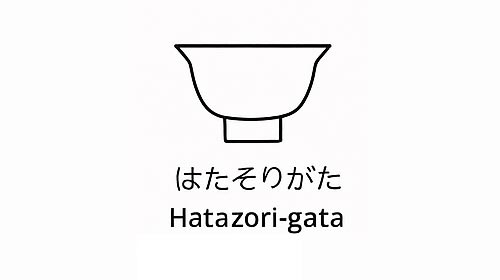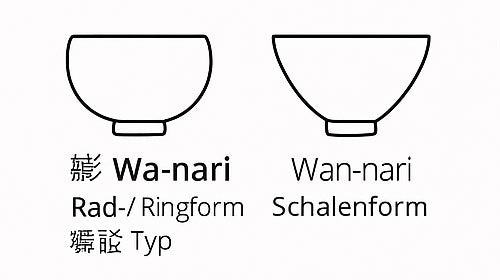Light, airy, open – the Hatazori-gata chawan is like a gesture of welcome. Its form extends outward, not in restraint, but in soft openness. "Hatazori" (端反り) literally means "outwardly curved edge," where "hata" refers to the edge and "soru" to the bend. The impression: a bowl that stretches toward the space and the moment.
This shape is one of the most expressive matcha bowls in Japanese tea aesthetics—and is especially favored during the summer months . Its open structure allows the tea to cool more quickly, while the view into the bowl remains unobstructed and creates a sense of spaciousness.
Origin and formal language
The Hatazori-gata has its roots in the Edo period (17th-19th century) , when chawan forms began to differentiate and become more closely aligned with seasons, spaces and aesthetic intentions.
It contrasts with the closed, introverted Tsutsu-gata (cylindrical form) or the heavy Sugi-nari (fountain form). Instead of leading into the depths, it invites one to explore the surface. It suggests spaciousness, air, and openness—attributes associated with summer, light, balance, and the idea of "hare" (a serene state) .
Typical features
-
Flat, wide-spreading rim , often with a gentle curve
-
Low construction height , which makes the width to height ratio larger than with classic Wan-nari
-
Wide open inner surface , ideal for evenly whipping Usucha
-
Relatively thin wall thickness , which underlines the lightness
In the hand, the Hatazori-gata feels light and balanced without being fragile. Its openness encourages mindful drinking—because it reveals what it contains.
The stand as a counterpole
The kōdai (foot ring) of the Hatazori-gata is often somewhat smaller , but precisely cut. It provides stability, balances the wide, spanning shape at the top, and gives the bowl an almost dance-like posture. Some bowls of this type have slightly inward-curved feet or rolled edges, reminiscent of delicate garments.
Typical ceramic styles
Hatazori-gata is preferably made with light, cheerful glazes . Particularly popular:
-
Ao-Hagi (pale Hagi blue with craquelure)
-
Kohiki (white slip with transparent glaze)
-
Oribe light (greenish with abstract brush decorations)
Often the surfaces are lively but not dominant – like a summer sky with movement but without heaviness.
Firing regions such as Hagi , Seto and modern workshops in Kyoto or Mashiko interpret the form with clear lightness.
Meaning in the tea ceremony
Hatazori-gata is the summer form par excellence. It is preferred during the hot months when the tea is allowed to cool quickly and the tea setting is open, airy, and flooded with light.
It symbolizes openness , both to one's surroundings and to one's fellow human beings. In classical tea aesthetics, it embodies the state of "hare" – light, clarity, happiness.
The tea master chooses it not only according to the season, but also according to his mood: it is an ideal vessel for guests who want to emphasize openness and cordiality.
Practical benefits
The Hatazori-gata is ideal for Usucha :
-
The wide interior allows generous movements with the chase
-
The smooth, spacious surface promotes the formation of a uniform foam
-
The rapid cooling prevents excessive heat – pleasant in summer
For Koicha , however, the shape is less suitable, as the tea is better compacted in deeper, more cylindrical bowls.




Leave a comment
This site is protected by hCaptcha and the hCaptcha Privacy Policy and Terms of Service apply.